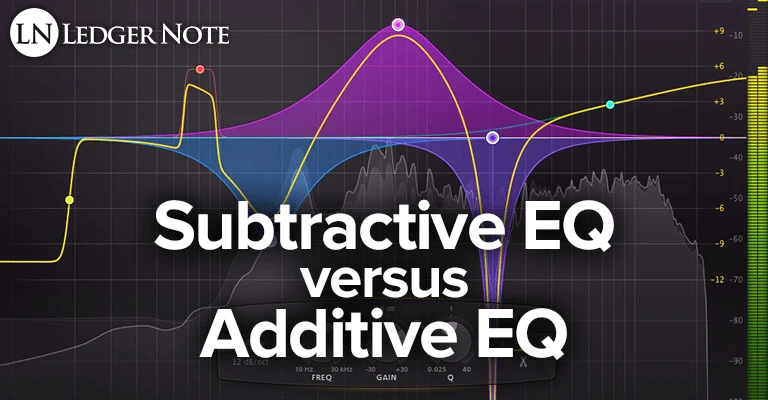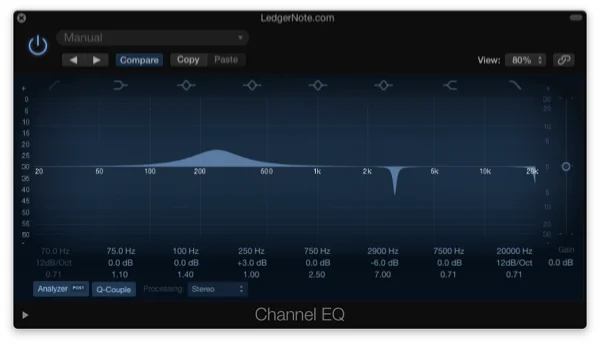
Since you’re reading this you’re likely familiar with the issue, but for the sake of those fortunate enough to not have dealt with it, let’s explain the typical conversation surrounding this topic.
It always boils down to some variation of:
- Cut instead of boost.
- Attenuate instead of amplify.
- Never add when you can subtract.
People have very strong convictions about this and half of the time can’t explain why, but someone they trust said it so they repeat it.
Even here on LedgerNote we’ve likely suggested it because it’s easier than taking a giant tangent or having disclaimers everywhere. But really…
It’s just a good rule of thumb, not a fundamental law of the musical universe.
What we’re going to do here is take a real look at each of the various reasons some studio engineers will use to support their arguments. We’ll dive in past the shallow certitude of “trust me, I’m an authority in the matter” and get into the meat of the facts.
What we’ll discover is which of these statements have aspects of truth, which are subjective based on taste, and which are flat out nonsense… Let’s go!
Any time this conversation rears its fearsome head, five main points are always made in support of cutting over boosting when dealing with equalization:
- Additive EQ uses active gain, therefore coloring your sound.
- Additive EQ is less accurate than Subtractive.
- Subtractive EQ frees up headroom while Additive eats it.
- Subtractive equalization creates less phase shift.
- Subtractive equalization sounds better than Additive.
Let’s work our way through these points one at a time, from top to bottom.
1) Additive Equalization Uses Active Gain & Colors Your Sound
Once upon a time, hardware equalizers would only use gain to boost your signal but not when attenuating. Boosting requires gain to increase the volume, which is the equivalent of increasing the voltage to boost the amplitude of the signal. There is some truth to this argument, but only some.
These days, almost every single hardware EQ is going to an active power source even when cutting. As a matter of fact, in all of my years of using and reading about equalizers I couldn’t afford, I’ve only encountered one that was presently being sold that used passive cutting. It’s always considered when people talk about the best mastering EQ, but that’s one out of countless.
The point is, it’s simply not very common any more. The circuitry has become more complex and always requires active power.
If nearly every hardware EQ requires active power, then this is a pointless argument. It also means all manufacturers felt the negative side was negligible or non-existent. They probably measured it too.
Here’s the other caveat. People make this argument knowing they’ve never touched a passive hardware equalizer and all the while knowing every single person they are talking to is using a digital EQ in the form of a plugin.
Plugin EQ’s don’t use any electrical power in the sense we are talking. So again, this is a pointless argument, one that you’ll never stop hearing.
Verdict: This argument made a lot of sense a million years ago. Today it has no real place in the discussion other than a side note for educational purposes.
2) Additive EQ is Less Accurate than Subtractive EQ
Right off the bat, anyone who’s spent much time mixing will want to know precisely what a person means when they use the word “accurate.” What definition are we using here? What connotation? What exactly do they mean?
They don’t know any more than you do. But it sounds good and technical. The reality is that additive and subtractive equalization is only as accurate as the settings you dial in, and no more or no less. I have a guess at where this argument comes from though.
Everyone realizes almost intuitively that you should boost wide and cut narrow. What this means is that you’ll make very precise decisions about what frequency to reduce in volume when using subtractive EQ (most of the time), but when using additive EQ you realize those precise decisions sound horrible.
Boosting only sounds decent (or ‘musical’) with a fairly wide Q bandwidth, meaning it is less accurate, but only because you’re choosing for it to be so.

Because otherwise it sounds like trash. You need wide, smooth transitions for a boost not to sound like a transient or error.
Verdict: This is a dirty gambit that seems to make sense on the surface. It’s like saying a motorcycle is less stable than a car because it only has two wheels instead of four, which is the entire point.
3) Subtractive EQ frees up Headroom while Additive Requires More
You have to look at this concept from two angles: from the point of view of a single track and from the view of the entire mix. In one way it’s true while in the other it’s not so true but not technically false.
Despite all the mumbo jumbo about equalization being performed through phase shifting (it’s true), the end result is an increase or decrease in volume. When you make a cut on a single track you are decreasing the overall volume of that track.
The opposite is true of boosting. In this way, it is true that you are using up more headroom by boosting than by cutting. But at the same time, you’ve recorded with proper gain staging so headroom isn’t an issue… right?
When it comes to the entire mix, you will be compensating for drastic boosts and cuts (which normally aren’t necessary anyways) by increasing or decreasing a track’s volume.
So that extra or less headroom will tend to be rendered meaningless in the grand scheme of things. It won’t affect your resolution, quality, or end result in mixing or mastering.
Verdict: The concept here is half true technically depending on the perspective, but pragmatically it doesn’t matter in the slightest because you’re going to compensate on the fader anyways.
4) Subtractive Equalization Creates Less Phase Shift
This can be proven to be false with a simple test. It’s easiest to do with shelf filters. We can walk through it quickly.
If you take a track and bus it out to two different auxiliary tracks, you can apply a shelf filter to each. On one, you’ll use a high shelf to boost the top half of the frequency spectrum.
On the other, you’ll use a low shelf to cut the bottom half of the spectrum. Make sure the corner frequencies, curve slopes, and amount of boost or cut are set the same so they are basically inverted versions of each other.
Now mute the original track and match the levels of the two auxiliaries. Take either one and apply a phase flip and you’ll find that they null each other out entirely. This means that neither the subtractive nor additive method introduced more of a phase shift than the other.

The reality is they were exactly the same. This is the case with plugins and nearly all modern, hardware equalizers. You can find edge cases if you really want to hunt to prove an irrelevant point.
Verdict: Both methods create an identical (and negligible) amount of phase shift. This is a false argument.
5) Subtractive EQ Sounds Better Than Additive
Like our discussion on the word “accurate,” what exactly does “better” mean? Is there even such a thing as being objectively better or does it all come down to taste and preference? Are salty snacks better than sweet snacks? Depends on who you ask and if you’re talking about health or taste, etc.
You can already see that this is a meaningless argument. It’s generally better to not engage anyone who can’t communicate more clearly than this, because it usually means that don’t think any more clearly either.
In general, cutting a thin Q curve out will sound far more transparent than boosting a wide Q. But is that better? Because I’d argue that you can create a more pleasing sound with a wide additive boost. Are we going for pleasing or transparent? Are you sculpting a sound or doing precision surgical mixing work?
It also depends on who is sitting behind the controls, their skill level, and the goal they’re trying to attain.
Verdict: This is a meaningless argument without diving into semantics and trying to figure out exactly what parameter we are measuring as “better.” And even then, it’s usually subjective.
Conclusion: Use Subtractive EQ Over Additive
It turns out none of the arguments that attempt to convince you that Subtractive EQ is inherently a better option that Additive EQ is true. Some are partially true, one was true in the past but presently false, and the others are completely subjective.
Why there is so much passion around this debate is beyond my understanding, but I do understand one thing: the entire conversation is silly.
The real deal is that both “sound” a certain way due to how they are used (wide boosts and thin cuts) and depending on how you listen (with the track solo’d or in the mix). Neither is better or worse than the other and it’s guaranteed that if you’re doing a good job you will use both to some degree.
The only thing you want to worry about when boosting is the effects of the Fletcher Munson curve, where humans have an increased sensitivity to the 1 kHz – 2 kHz range. What is technically a 3 dB boost may end up feeling like a 10 dB boost when the volume is increased.
This debate in general is not something to worry your head about! Additive EQ and Subtractive EQ are both worth their weight in gold.